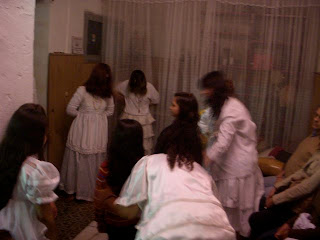At long last, balmy spring has arrived to the Rio de la Plata, although the Americans seem to be the only persons using shorts and sandals so far. Since August I've been enjoying plenty of time in Uruguay, saving money, interviewing all sorts of interesting folks for my research, and taking advantage of the many festivals that take place as the cold starts to go away.
Recently I was happy to have a South American reunion with Robin, who I met as a fellow intern at the US Embassy in Santiago, Chile in 2006. After a business trip in Buenos Aires she was a good enough friend to make the trip to Montevideo just for one night. Here we are trying to cram a number of important Uruguayan symbols into one shot: the Palacio Salvo, the tomb of José Artigas, and the iconic maté and thermos.
One of Montevideo most exciting annual events is the Semana Rural, which is essentially large stock show where ranchers show off their prize cows, sheep. chickens, etc. and the food is in great supply for non-livestock aficionados like me. Here is a sedated sheep getting ready to lose its winter coat.
My boyfriend Facundo's quasi-public company INIA had a stand at the fair, which highlighted its work in sustainable methods of crop production. Uruguay is an agricultural powerhouse when you consider its small size, and INIA is one of the research institutes that keeps it on the cutting edge of innovation in all sorts of products, from rice, wines, and blueberries.
Here is me paying homage to what is probably my favorite thing in Uruguay: the delicious free-range Hereford meat that has caused me to gain the happiest 5 pounds of my life.
The next few pictures capture what was undoubtedly the most interesting night in Uruguay. After having been in touch with Mae Susana, a religious leader of the an Afro-Brazilian Umbanda movement in Montevideo, regarding my research on issues of church and state in Uruguay, I was kindly invited to one of their ceremonies. This particular ceremony celebrated Xangó, the deity of justice. The alter shown in the photo has been set up in honor of him, and the cakes and soda pop below are offerings from children to Xangó for good luck in their exams.
The picture below captures the most fascinating part of the ceremony. The women dressed in white became possessed by deities known as Orixás, spun in circles to the rhythm of Afro-Brazilian atabaque drums. Mae Susana, also possessed by an Orixá, led the ceremonies and rid spectators of evil spirits and spoke in Portuguese. As an outsider I'm sure I cannot accurately convey everything that was going on, but suffice to say it was absolutely fascinating to witness.
Finally, one of the highlights of the past few months was the Dia del Patrimonio in early October, in which the country's museums and most important historic buildings (many of which are closed to the public the rest of the year) open their doors. Thousands of people take advantage of the opportunity to celebrate their country's history and enjoy all sorts of live entertainment. The perfect weather made it a very enjoyable weekend. Here's a picture of Montevideo's Plaza Cagancha, where some of the city's most important buildings are located, including the Supreme Court (the highlight of the day for me).
The highlight of the following day was the once-a-year chance to see the workshop of Uruguay's most famous sculptor José Luis Zorrilla de San Martín, son of Uruguay's iconic poet Juán San Martin and father of celebrated Uruguayan actress China Zorrilla. Here is another of San Martín's daughters sharing some personal stories.
And here's the younger San Martín's homage to his father, the great Uruguayan poet Juán San Martín. The statues made from these molds are found throughout the country.
And last, I can't resist posting one photos that captures something I notice on a daily basis in Uruguay, and that is the extraordinary popularity of the color purple among women of all ages here. My friends Kay and Andrea visiting from the US also noticed that purple is the rage this year in the Rio de la Plata, and I have seen classy leather stores that sell purses and shoes in black, brown and purple. And if I had a peso for every time I've spotted purple denim pants since I arrived, I might have the equivalent of Uruguay's GDP.










No comments:
Post a Comment